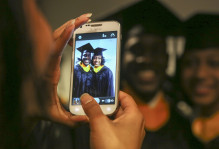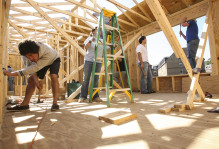Office of Community Engagement and Scholarship to Educate a New Generation of Citizen Scholars
Fifteen years ago members of the William and Mary Board of Visitors approved a strategic plan. That plan included in it the recommendation to establish a central clearinghouse of information for community service opportunities. In an effort to evoke a culture of service, the office established partnerships with local non-profit agencies and energized a small but dedicated base of student volunteers. Soon after, awards for service were created and conversations on how to deepen engagement were initiated. There have been many seminal moments in this 15 year adventure – including a few events and subsequent programs that have charted our path – and are now a part of our history.
First: September 2001 will forever be remembered as a watershed month for our nation. It also provided a defining moment for community engagement at W&M. The Sharpe Community Partnership Program welcomed its first cohort of engaged scholars and the tragedy of 9/11 awakened a generation of college students to a new form of activism. Samanthe Tiver recently wrote, “Like many William and Mary students, I had many years of experience in volunteerism and community service. But rarely did I critique my work in the context of larger community-wide solutions. Soon I was thrown into this world of Sharpe Community Scholars, where I realized that who I am, what I study, and how I serve are inherently connected.”
Guided by dedicated faculty and impassioned students, we changed the way we do business. In the years following, students came to W&M expecting more of themselves and of their education. They graduated from Sharpe with a desire to think more deeply, to dream bigger, to do more and to effect change.
In late September 2001 Becca Luhrs, a sophomore, approached me with the idea of bringing students on an international service trip. Little did we know that her idea would not only come to fruition but it became the first of now dozens of successful trips. In November 2007 the executive director of the national organization for alternative breaks commented during a visit to W&M that we have more international service trips than any other school that is part of the nonprofit organization. While the number of programs is impressive, the quality of the experience is the characteristic that is really worth publicizing.
Today many students who are witnessing injustice, poverty, insufficient health care and abuse are returning to William and Mary with a desire to connect their newfound reality with their coursework. After making an emotional connection with members of very distinct populations, they return to campus with a desire to learn about a wide array of social concerns from an even broader array of disciplines. A business major sees him or herself as a potential social entrepreneur. A sociologist understands why she studies cultures and now has a laboratory. Professors Aday, Schwartz, Griffin and others greet their energy with a strategy for integrating learning, teaching, and research while working with communities.
Building Tomorrow, Students Helping Honduras, George, Cosmo and Jeree are part of the brand that now defines engagement and William and Mary. With the Sharpe program as their foundation and the emotional tug of their friends in underrepresented communities as their inspiration, students begin a lifetime of global engagement.
Students were insisting that their learning be dynamic and that it span beyond the boundaries of campus. So we responded. And what has unfolded, what is still evolving is what you see today. Examples include 325 tutors in Williamsburg, regular trips to Petersburg, alumni partnerships in community-based learning, a dozen domestic service trips and programs across Latin America and in African countries. Students and faculty work together with community members asking questions aimed at finding solutions to a myriad of social concerns…problems that we realize will take years, maybe decades and possibly a lifetime to help solve. But, it is in Williamsburg, Richmond, on the eastern shore and Petersburg, Honduras and Tanzania that students are emerging as advocates, their interest in scholarship is blossoming, their passion coming into focus. It is in speaking with community members that they are conducting their first qualitative research. They are considering the role of the anthropologist, the doctor, the sociologist, the pastor and often for the first time seeing themselves fitting into a role. It is in these moments alongside community members, with their peers and beside their faculty that they are making meaning of their life. They are finding purpose.
It is in these moments of emotional inspiration and intellectual curiosity that our new office assumes its central mission. In supporting students’ personal development through service, and providing students the chance to explore their newfound intellectual curiosity, we become a portal through which 21st century liberal arts education is achieved.
We have reached a turning point. Our numbers rival those of any university in the nation. Now we have the chance to lead higher education in defining the liberal arts university in the 21st century.




No comments.
Comments are currently closed. Comments are closed on all posts older than one year, and for those in our archive.